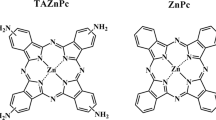Abstract
Chalcogenapyrylium (CP) dyes which are specifically activated by red and near infrared light (600–900 nm) were examined as potential photosensitizers for photochemotherapy of malignant gliomas. Eleven CP dyes of varying chemical structure and redox potential were evaluated for selective toxicity against glioma and normal skin fibroblast cell cultures both before and after light activation. Eight of eleven CP dyes exhibited differential toxicity to tumor over fibroblast cells at dye concentrations of 1.0 µM. Dose dependent toxicity was seen both in the dark and after laser light activation. The toxicity of two of the CP dyes was significantly enhanced by photoactivation with 800 nm light.
The CP dyes that absorb light maximally between 775 and 850 nm, in the range of excellent light penetration through brain, appear to be promising candidates as photosensitizers for treating malignant brain tumors.
Similar content being viewed by others
References
Diamond I, Granelli SG, McDonagh AF, Nielson S, Wilson CB, Jaenicke R: Photodynamic therapy of malignant tumours. Lancet 2: 1175–1177, 1972
Laws ER, Wharen RE: Effects of photoradiation therapy on normal rat brain. Neurosurg. 15: 808–809, 1984
Boggan JE, Walter R, Edwards MSB, Borcich JK, Davis RL, Koonce M, Berns MW: Distribution of hematoporphyrin derivative in the rat 9L gliosarcoma brain tumor analyzed by digital video fluorescence microscopy. J. Neurosurg. 61: 1113–1119, 1984
Kaye AH, Morstyn G, Ashcraft RG: Uptake and retention of hematoporphyrin derivative in an in vivo/in vitro model of cerebral glioma. Neurosurg. 17: 883–890, 1985
Powers SK, Pribil S, Gillespie GY, Watkins PJ: Laser photochemotherapy of rhodamine-123 sensitized human glioma cells in vitro. J. Neurosurg. 64: 918–923, 1986
Banes AJ, Link GW, Beckman WC, Camps JL, Powers SK: HPLC quantitation of rhodamine 123 and 110 from tissue and cultured cells. J. Chromatography 356: 301–309, 1986
Edwards MSB: Photosensitization of malignant glioma cells with acridine orange. Sixth International Conference of Brain Tumor and Therapy. (Abstract), 1985
Ben-Hur E, Rosenthal I: Photosensitized inactivation of Chinese hamster cells by phthalocyanines. Photochemistry Photobiology 42: 129–133, 1985
Ben-Hur E, Carmichael A, Riesz P, Rosenthal I: Photochemical generation of superoxide radical and the cytotoxicity of phthalocyanines. Int J Radiat Biol 48: 837–846, 1985
Svaasand LO, Ellingsen R: Optical penetration in human intracranial tumors. Photochemistry Photobiology 41:73–76, 1985
Wharen RE, Anderson RE, Laws ER: Quantitation of hematoporphyrin derivative in human gliomas, experimental central nervous system tumors, and normal tissues. Neurosurg. 12: 446–450, 1983
Wise BL, Taxdal DR: Studies of the blood-brain barrier utilizing hematoporphyrin. Brain Research 4: 387–389, 1967
Winkelman J, Rasmussen-Taxdal DS: Quantitative determination of porphyrin uptake by tumor tissue following parental administration. Bull. Johns Hopkins Hosp. 107: 228–233, 1960
Gomer CJ, Jester JV, Razum NJ, Szirth BC, Murphree AL: Photodynamic therapy of intraocular tumors examination of hematoporphyrin derivative distribution and long-term damage in rabbit ocular tissue. Cancer Research 45: 3718–3725, 1985
Davis S, Weiss MJ, Wong JR, Lampidis TJ, Chen LB: Mitochondrial and plasma membrane potentials cause unusual accumulation and retention of rhodamine 123 by human breast adenocarcinoma-derived MCF-7 cells. J. Biol Chem 260: 13844–13850, 1985
Cohen RL, Muirhead KA, Gill JE, Waggoner AS, Horan PK: A cyanine dye distinguishes between cycling and non cycling fibroblasts. Nature 290: 593–595, 1981
Cercek L, Cercek B: Effects of ascorbate ions on intracellular fluorescein emission polarization spectra in cancer and normal proliferating cells. Cancer Detection and Prevention 10: 1–20, 1987
Emaus RK, Grunwald R, Lemasters JJ: Rhodamine 123 as a probe of transmembrane potential in isolated rat-liver mitochondria: spectral and metabolic properties. Biochim et Biophys Acta 850: 436–448, 1986
Mewes H-W, Rafael J: The 2-(dimethyl-aminostyryl)-1-methylpyridium cation as indicator of the mitochondrial membrane potential. FEBS Letters 131: 7–10, 1981
Bereiter-Hahn J: Dimethylaminostyryl-methylpyridiniumiodine (DASPMI) as a fluorescent probe for mitochondria in situ. Biochim et Biophys Acta 423: 1–14, 1976
Detty MR, McKelvey JM, Luss HR: Tellurapyrylium dyes. 2. The electron-donating properties of the chalcogen atoms to the chalcogenapyrylium nuclei and their radical dications, neutral radicals, and anions. Organometallics (In press).
Detty MR, Murry BJ: Tellurapyrylium dyes. 1. 2, 6-Diphenyltellurapyrylium dyes. J. Org. Chem. 47: 5253–5239, 1982
Detty MR, Luss HR: Tellurapyrylium dyes. 3. Oxidative halogen addition and tellurium-halogen exchange. Organometallics 5: 2250–2256, 1986
Summerhayes IC, Lampidis TJ, Bernal SD, Nadakavukaren JJ, Nadakavukaren KK, Shepherd EL, Chen LB: Unusual retention of rhodamine 123 by mitochondria in muscle and carcinoma cells. Proc. Natl Acad Sci 79: 5292–5296, 1982
Lampidis TJ, Bernal SD, Summerhayes IC, Chen LB: Selective toxicity of rhodamine 123 in carcinoma cells in vitro. Cancer Research 43: 716–720, 1983
Pedersen PL: Tumor mitochondria and the bioenergetics of cancer cells. Prog Exp Tumor Res 22: 190–274, 1978
Effert HR, Blazek V: Optical properties of human brain tissue, meninges, and brain tumors in the spectral range of 200 to 900 nm. Neurosurg. 21: 459–464, 1987
Author information
Authors and Affiliations
Rights and permissions
About this article
Cite this article
Powers, S.K., Walstad, D.L., Brown, J.T. et al. Photosensitization of human glioma cells by chalcogenapyrylium dyes. J Neuro-Oncol 7, 179–188 (1989). https://doi.org/10.1007/BF00165102
Issue Date:
DOI: https://doi.org/10.1007/BF00165102




